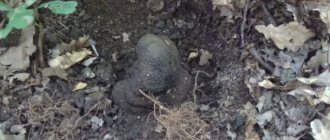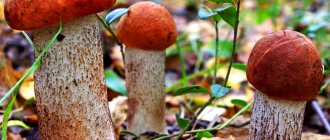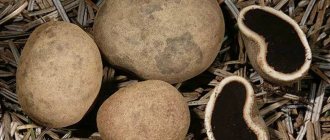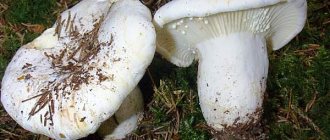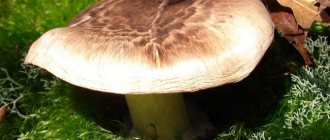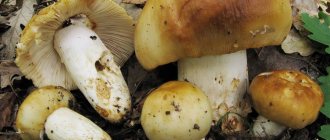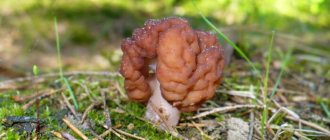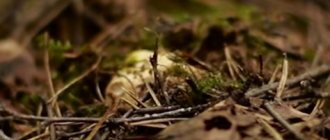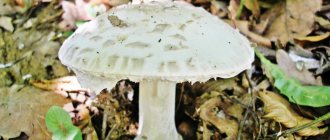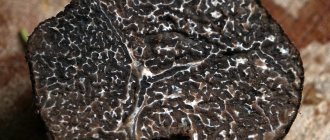General features of Truffle mushrooms, botanical description
Truffles are mushrooms of the marsupial genus. They look unattractive, but at the same time they have an amazing bright taste and aroma. We can say that such a product smells like a forest. It has an unusual aroma of earth, foliage, and trees.
Mushrooms grow in an unusual way - underground. They are located between the roots of trees. It can be birch, beech, oak, linden, poplar.
Truffles develop and in the process draw nutrients from the roots of the tree that they need for normal growth and development. In this case, the mushrooms do not cause any harm to the plant. The tree is still growing fully.
Mushrooms love mixed or deciduous forests most of all. You should not try to find them in coniferous thickets. It is most comfortable for truffles to grow in soil with lime.
More about mushrooms:
| Peculiarities | Characteristic |
| Mushroom size | 12-15 cm |
| Mass of mushrooms | up to half a kilo |
| Ripening time | from August to November |
Truffles have a tuberous, round shape. They are fleshy, but cartilaginous inside. Mushroom size: from hazelnut to medium potato tuber. The outside of the fruit is covered with thick skin. It can be either smooth or covered with cracks or “warts”. If you cut a mushroom, you will notice a special marble pattern inside.
Varieties of Truffle mushrooms.
Truffles also have another name – “royal mushrooms”. This is because they are the most expensive in the world. Some sellers today ask for more than 250 thousand rubles for 1 kg of truffles.
It is the mushrooms of Italian and French origin that have become famous throughout the world. In these countries, truffles are harvested almost all year round. Each season there are different varieties. Either white, then black, or banchetto. The first option is considered the most sophisticated. White truffles must not be bred independently.
They grow naturally in some areas. The product goes on sale from October to January. The cost depends on the type of truffle. Once, 1 kg of such porcini mushrooms was sold at an auction in Italy for more than 90 thousand euros.
Poplar row, how to cook. Poplar row mushroom, preparation, 4 recipes for delicious dishes
The main advantage of the poplar row mushroom is the ability to prepare dishes from it that have a surprisingly pleasant smell and taste.
Salted and pickled preparations from this species retain its natural aroma, similar to the smell of fresh cucumber and flour, and fried poplars resemble the taste of truffles.
Let's learn more about the poplar mushroom and preparing dishes from it.
- minerals - phosphorus, selenium, calcium;
- acids - oxalic, tartaric, citric;
- natural enzymes that can break down and prevent the accumulation of fats and glycogen;
- B vitamins, vitamins A, PP, C.
- These substances speed up metabolism, normalize cholesterol and blood sugar levels, increase appetite, and have a positive effect on blood pressure and gastrointestinal function.
Mushroom row, description
Poplar mushroom is not the most popular catch for mushroom pickers. Many lovers of “silent hunting” do not take it, considering it conditionally edible.
The reason for this is the ability of the mushroom to absorb dirt and harmful impurities from the atmosphere. It is worth abandoning poplar clearings that grow near roads located less than a kilometer from populated areas.
The collection of safe poplar rows is carried out in remote places. They are most often found on sandy soils under poplars, aspens, walnuts and pine trees.
They grow in groups, forming rows or rings. If one specimen comes into view, then you can probably find a whole clearing of its fellows around.
In the people and in reference books they have many different names: poplar, sandpiper, frost, zabaluika, poplar and sandstone.
Poplar can be recognized by the shape of its cap. This part of the young floodplain has a hemispherical shape, over time it turns into depressed and becomes covered with cracks.
Color - brown with yellowish, gray, brick-red. The pulp has a reddish tint with a mealy-sweet taste.
The poplar blades are thin and frequent. The color of young plates is white, cream and pinkish. In the old specimen, the plates are covered with reddish spots.
The leg has the shape of a cylinder with a scaly surface. Leg size: 1-4 cm in diameter and 3-12 cm in length.
When searching, it will be useful to arm yourself with a stick in order to stir up the foliage under which the rows like to hide.
Due to the nature of their growth, they are heavily soiled with soil and rotted leaves. Therefore, before cooking, it is necessary to clean the floodplain with a brush.
Podtopolnik contains useful vitamins and microelements:
Official pharmacology uses enzymes contained in poplar pulp in the production of anti-tuberculosis drugs.
Do truffles grow independently in Russia, geography of distribution
The Truffle mushroom, a photo and description of which is published later in the article, also grows in Russia. They are found in different regions of the country. For example, it is possible to find such mushrooms on the Black Sea coast, in the Oryol, Samara, Vladimir, Leningrad and even Moscow regions. Truffles are also found in the Caucasus and the Volga region.
In Russia there is a special “Russian truffle”. This is a black summer mushroom that has an impressive weight - approximately 350-370 g. Its length is usually 9-10 cm. The age of a Russian truffle can be determined by the consistency and color of the pulp.
It can be white, yellowish, brown. Young mushrooms have dense flesh. Later it becomes more loose. Mushrooms have a sweetish taste and aroma. It resembles a mixture of hazelnut and seaweed.
Black Sea coast of the Caucasus and Crimea
Crimea and the Black Sea coast have a mild and extremely comfortable climate. These areas have everything necessary for the normal development and active growth of fungi. In these areas there are a large number of oak groves, which are especially popular with truffles. They are concentrated as much as possible in Crimea - in the steppes, the Caucasus, and North Ossetia. Gelendzhik and Anapa especially stand out.
Urals
Truffles are also actively growing in the Urals. They are comfortable in forests with a large number of coniferous and broad-leaved trees.
In the Urals it is possible to find several varieties of the mushroom:
- brilliant red (with a pleasant aroma of pear, coconut and fleshy pulp);
- red (with a delicious aroma of coconut and fresh grass);
- white, pubescent (not very tasty, not suitable for culinary experiments).
Middle Volga region
Rare white truffles grow in the Middle Volga region. They can be collected from August until frost (until December). As a result, delicious, aromatic tubers grow. Mushrooms feel comfortable in the moist soils of dense old forests with birch, oak, and hazel.
It is recommended to look for fruits near large trunks. During the process, you need to pay attention to the small tubercles that appear above the fruiting body. They will tell you the exact location of the mushrooms.
Siberia
The delicacy also grows on Siberian soil. Even a black summer truffle was discovered in the Tomsk and Chelyabinsk regions. Moreover, it was found in large quantities - 2.5-3 kg in one place.
Truffles were first discovered in Siberia in the 19th century. Fruits here grow not only individually, but also in groups. Mushrooms love coniferous and deciduous forests most of all. There are especially many truffles in the Tomsk region. In recent years, residents of this region have begun to collect rare mushrooms in literally kilograms. This is due to natural conditions favorable for the growth of truffles.
Mushrooms that grow under poplars. Where do floodplains grow and when can they be collected?
You can find mushrooms in Eastern and Western Europe, Canada and Central Asia.
In Russia they are common in Siberia. In most cases, they grow in rows and heaps. From the name it is clear that the mushroom grows in close proximity to poplars. Therefore, they must be collected in deciduous forests. Podtopolniks usually hide in the ground and under leaves.
Fruiting begins in mid-August. If the weather is favorable in the fall, then the row can be collected until mid-October.
Due to their ability to absorb harmful substances, it is not recommended to collect mushrooms in industrial areas and near the road. Experienced mushroom pickers know that when you find one poplar row, you need to look around, since there should be a whole family of poplar mushrooms nearby. When a group of mushrooms is found, you need to carefully remove the leaves and soil from them, and then cut off the stem with a knife.
Inexperienced mushroom pickers may confuse the mushroom plant with the voluptuous mushroom, which can cause an eating disorder. Therefore, there is no need to collect mushrooms under coniferous trees. Another difference is that wavy-legged specimens do not grow in groups. In the image below you can see what a poisonous mushroom looks like.
Another difference between Potopolnik and other mushrooms is the pronounced floury or cucumber smell. In addition, they hide, so you can only notice a round brown cap that resembles a potato.
Also, some mushroom pickers confuse the undertopolnik with the crowded row (picture below).
There is nothing wrong if you pick this mushroom, as it is also edible. If you are going to the forest for mushroom hunting for the first time, it is better to ask an experienced person to accompany you.
Varieties, characteristics of truffle mushroom
Truffle mushroom (photo and description will teach you to distinguish it from other species) comes in different varieties. First of all, they differ in terms of ripening. There are summer and winter truffles, as well as white and black.
Summer truffle (Tuber aestivum)
This is an edible version of the mushroom. It is also called "Burgundy". Truffles ripen throughout the summer months. This process ends only late in autumn. The exact ripening period depends on the region. In the North, this period is already approximately from the end of July to the end of November.
This type of mushroom can be located at different depths underground. Usually it is 3-15 cm. Ripe fruits can be found both individually and in groups. These truffle varieties rarely grow close to pine and birch trees. Usually you can find them near oaks, beeches, and hornbeams. A large number of them can be found on the Black Sea coast and in the southwestern part of the country.
Winter truffle (Tuber brumale)
Such mushrooms can reach 18-20 cm in diameter. Each one is covered with a large number of “warts”. The diameter of the latter turns out to be approximately 2-3 cm. Fresh winter truffles still growing underground are reddish-purple on the outside. Soon after collection they change color. The skin of the mushrooms darkens significantly or may even turn black.
The truffle pulp is initially snow-white. Afterwards it becomes first gray, and then with a purple tint. The pulp has many yellow and white veins. The weight of one mushroom can exceed 1 kg.
The ideal place for the growth of winter truffles is oak or birch groves. Such mushrooms are also comfortable in beech forests. The fruits actively ripen from late autumn to early spring. Separately, it is worth noting the bright unusual aroma of mushrooms. It resembles musk.
Italian truffle (Tuber magnatum)
This version of truffle has irregularly sized tubers. They are also underground, approximately 4-12 cm long. The weight of the fruit ranges from 30 to 250 g. It can even reach up to 300 g. The pulp of the mushrooms is dense, but not too hard. It can be of different shades. Most often - from white to gray-yellow. Sometimes there are mushrooms even with reddish flesh.
Sometimes a marble pattern is also seen on it. It comes in both white and brown-cream. Italian truffle has a bright spicy aroma. And its taste is unusual. It resembles a mixture of grated hard cheese and fresh garlic.
Italian truffles most often grow under poplar, oak, and willow. Less commonly, their fruits can be found under linden trees. These mushrooms love deciduous forests with loose soil (preferably limestone). Truffles grow in it at different depths.
Italian truffles can be collected both in summer and winter. Officially, its collection begins at the end of September. The process ends in the last days of winter.
Black or Perigord truffle (Tuber melanosporum)
Such mushrooms are also called “Périgord’s treasures.” They grow up in France. This version of truffles is called the most exquisite. It is one of 8 edible varieties of mushrooms. In total, about 30 varieties of truffles are known.
There are several other names for such mushrooms. These are, for example, “black gold”, “black diamonds”, “black princesses”. The edible tubers appear completely black. But their flesh when growing in the ground is light. After the truffles are removed, their flesh gradually darkens. It becomes black and purple with light veins.
The name of the truffles refers to the French region where they are most often collected. But you can find the delicacy throughout the country. Mainly in the southeastern part. Such mushrooms are grown in Italy, Spain, and China.
The fruits are underground. The depth is approximately 5 to 30 cm, so they are quite difficult to find. Such truffles are very picky about the choice of tree near whose roots they grow. Most of all they love oak or hazel trees.
The mycelium envelops the roots of the tree, thanks to which the latter begin to perfectly absorb water and mineral salts. It also protects the roots from many diseases. For example, from late blight. True, all other vegetation near the tree dies. An impressive circle is formed, which tells you where to look for mushrooms.
Opinions about the aroma of mushrooms are divided. Some gourmets are sure that they smell like chocolate. And others - like the dampness of the forest with a hint of cognac.
Poisonous and inedible types of mushroom
As noted above, out of 30 types of truffles, only 8 are edible. The rest are unacceptable for food because of their not very pleasant taste. Some varieties of mushrooms are completely poisonous.
Thus, truffle collectors most often encounter “Deer”. It is a mushroom with round fruits, each of which is approximately 2-4 cm in size. It is yellowish-brown with a pungent, bright aroma. The smell is reminiscent of potatoes. The entire surface of the fruit is covered with small tubercles.
This inedible mushroom grows under coniferous trees, oaks, and chestnuts. It ripens en masse in the last month of summer and in autumn. Deer eat such truffles with pleasure, which is how they got their name. Hares and squirrels also feast on these mushrooms.
Poisonous and inedible truffles usually bear fruit on the surface of the soil. And the delicious fruits are underground. Also, edible mushrooms are dense, but dangerous ones can be easily squeezed with your fingers.
Edibility
With good reason, false truffles cannot be called poisonous, although they are unsuitable for human consumption. But deer, rodents, wild boars and other mammals eat them with pleasure.
Although it is not difficult to confuse edible and inedible mushrooms, you should not be too afraid of making a mistake. As already mentioned, false truffle is not poisonous, but it has an unpleasant taste and can cause food poisoning. However, for poisoning you need to eat a considerable amount of mushrooms, which is extremely difficult to do unintentionally due to their taste.
Important! Although parga is inedible for humans, it is consumed as an aphrodisiac in some regions.
Features of growth
The Truffle mushroom grows underground, as evidenced by its detailed description and photo. It is always located at the roots of the tree. Without them, truffles have nowhere to get nutrients.
But if you wish, you can grow such mushrooms even at home. For this, hazel or oak seedlings are used. The seedlings are left in sterile conditions for several weeks. This is required for the mycelium to take root. Only then are the resulting seedlings planted in the nursery. This can be done in the spring.
First, a small amount of water is poured into the hole. And only then it is densely covered with fathoms of soil and watered again. Near each of them a layer of forest soil with leaves and a film must be laid.
Gray row: photo and description
The large family of agaric mushrooms includes a huge number of edible species. These include the gray row, the collection of which begins in August and continues until the end of September.
In today’s article we will look at the species characteristics of this mushroom, and also pay attention to its beneficial properties and the rules for preparing delicious dishes from the row.
What properties does the gray row mushroom have?
Before you go into the forest to pick mushrooms, you need to thoroughly study the edible and poisonous types of mushrooms. The good news is that most of its varieties are safe and edible (Figure 1).
How can one distinguish edible mushrooms from poisonous ones? Outwardly, they are very similar, so the procedure for distinguishing an edible mushroom from a poisonous one is complex.
To do this, it is important to learn the characteristic features of each type:
- Edible ones have an attractive appearance. The color of the caps and legs can be different (lilac, pink, violet, gray, etc.). If you look under the cap, you can see the bright plates located under it. The flesh of an edible mushroom will also be the same shade as the plates under the cap.
- The caps of poisonous mushrooms in almost all species will be flat, perfectly smooth and white. The main difference between the poisonous variety will be a pungent, unpleasant odor that can even make you wince.
Among the rows there is also a conditionally edible variety - earthy-gray. It used to be considered edible, but recent studies have shown that consuming large quantities of mushrooms can cause serious muscle tissue breakdown.
Figure 1. Rowers are classified as agaric mushrooms
Experienced mushroom pickers note that some mushrooms of this species have a simply unique taste. Therefore, we recommend trying to cook each of them.
You can also salt them for the winter or freeze them. Then, with the arrival of winter, you will always have the opportunity to diversify the menu with delicious dishes.
Description and photo
The family of agaric mushrooms has about 2,500 species. Ryadovka also belongs to this group, and got its name because it grows in large colonies arranged in a row (Figure 2).
Note: Sometimes the rows of mushrooms are arranged in the form of rings, which are popularly called “witch circles.”
An adult mushroom, depending on the type, can have a diameter from 4 to 22 cm. There is a pronounced tubercle on top of the cap, while the edges remain smooth.
The mushroom cap can vary in color from brown, purple, yellow to gray and green. Under it there are thin and frequent plates. The height of the leg reaches 10-12 cm, and the thickness can be from 1-2 cm and, as a rule, it is colored pink-brown.
Self-harvesting, how to look for truffles
When collecting truffles yourself, you need to remember that they most like clearings with a lot of light, the edges of oak forests. Less commonly, such mushrooms can be found in birch groves and among aspens.
Searching for truffles in the forest
If it is not possible to use the help of animals that search for truffles, then you can find them yourself. To do this, you will need to carefully study the ground in the forest. Truffle sites are distinguished by the fact that the soil in them acquires an ash-sulfur hue. These areas have weak grass and dry, stunted moss.
If the zone looks truffle-like, then you need to carefully look at the hillocks of the earth. One mushroom or several at once can be hidden under any of them. While it is recommended to pick other wild mushrooms early in the morning, while they are still fresh and strong, this is not necessary with truffles. You can go to the collection at any time of the day.
Truffle hunting animals
Truffles have a very bright, rich aroma. They smell especially strong when fully ripe. A person does not always feel this smell, but animals can smell it from afar. Today there are entire special schools where dogs are trained to search for truffles. Pigs are also great at finding them.
It is important not only to find the mushroom, but also to correctly remove it from the ground. The shell of the fruit or the root of the tree must not be damaged in the process. In the first case, the fruit will almost completely lose its value. And in the second, the famous place for collecting truffles will disappear.
Interestingly, mushrooms can be detected by midges and other insects by smell. On a sunny day near sunset, they begin to swarm over the area where truffles grow underground. In these places the ground is also dug up. After all, hares, moose, badgers, and foxes are also trying to find the appetizing delicacy.
You can even train your dog to search for truffles on your own. To do this, she will need to be given a sniff of the fragrant mushroom at least once.
How to collect truffle mushrooms
To collect truffles you only need a little - a basket, a knife and a specially trained dog or pig. Previously, only pigs were used, but these animals did not mind eating such a delicacy and had to be shared with them. From a young age, the pig is trained to smell it.
If such a smell is detected, it will begin to dig the ground and at this moment it is necessary to quickly drive it away, since the pig will simply eat the prey . It is difficult for such animals to search over large areas and are incapable of long-term work, as they quickly get tired. After your pet finds prey, don't forget to reward him with peas or boiled beans.
Since there is a high probability that the prey during the search will be eaten by a pig, they began to use dogs. These animals are indifferent to beans, and they search no worse than pigs. Such dogs are quite expensive, costing several thousand dollars, but they can bring you much more benefits. They need to be accustomed to the smell of truffle while still a puppy.
To do this, you need to drink milk with mushroom broth. Don't forget about training. You need to do the following:
- Take any stick;
- Rub it with mushroom.
- Hide, gradually increasing the territory. Start with a room, then hide it in the garden, and then in the middle of the forest;
- Don’t forget to reward your pet after each time the dog is around.
After a dog or pig finds prey, it is necessary to quickly remove them, as they will immediately begin to dig the ground, thereby potentially damaging the find. Then follow with extreme caution. Clear enough space around the find and then cut it off without damaging its surface or the area where it grew, as a new one will grow there again. They grow in clusters, often very close to each other. When cutting, there is no need to damage the remaining mushrooms. Next, put the mushrooms in a basket or bag and enjoy the spoils.
Interesting facts about the mushroom
There are several interesting facts about mushrooms:
- the fruits in cross-section resemble “defective” potatoes, so in the old days they were thrown away and called “lumps”;
- Truffles do not have legs or caps, they are solid tuber-shaped fruits;
- the spores by which mushrooms reproduce are found in their very pulp;
- It is believed that everyone who tries a truffle at least once in their life will never forget its bright, unusual taste and aroma;
- According to studies, about 10% of people find the smell of truffle disgusting (for them it smells rotten);
- edible mushrooms never come to the surface; they can only be found deep in the ground;
- it is believed that without prior preparation a person will not be able to independently find truffles in the forest without the help of animals (or without detailed instructions from professional pickers).
What does a gray row look like? Gray row: photo and description
Tricholoma portentosum is a common edible, relatively large mushroom. The gray rower got its name, as noted above, for its ability to grow in rows and rings and for the gray color of the cap. It is often called the hatched or little mouse because of its resemblance at a young age to a small gray mouse. It belongs to the lamellar mushrooms.
What does a gray row look like? The spores necessary for the reproduction of this fungus are found in the plates. The latter are wide in shape, very sparse, slightly sinuous. In young mushrooms they are almost white, while in more mature ones they are gray, with a yellowish tint. The cap of the gray row is fleshy with wavy edges and slightly noticeable blackish radial fibers. Young mushrooms have rounded conical caps, while mature ones are uneven, often spread out, with a flat tubercle in the center. And the edges of the caps of young mushrooms are slightly curled, while those of mature ones crack over time, bending upward.
Based on the color of the cap, they are mostly a pale grayish or dark gray shade, but are often found with violet, olive and lilac shades. The surface is smooth, slimy and sticky in wet weather, which is why leaves and grass stick to it. The stem of the gray row is slightly thickened, cylindrical in shape, smooth and dense, longitudinally fibrous and deeply set in the foliage or moss. The gray-yellow-white flesh in the cap is dense, but rather brittle, and in the stem it is loose and fibrous.
It is believed that the mushroom has a mild, persistent powdery odor and taste. However, there is an opinion among mushroom pickers that its smell is more like the smell of stale, damp and musty flour, and it is definitely not spicy.
Autumn row mushroom. The gray hat is clearly visible in the autumn forest. Some specimens can be found in the summer (August), but the row is especially numerous in the fall (September-October).
It is believed that this mushroom has the best taste among all edible varieties of rows.
Why is truffle the most expensive mushroom in the world?
Truffles are the most expensive mushrooms. Their high cost can be easily explained. First of all, these are the difficulties of collection. People who collect such mushrooms today undergo special long-term training and preparation. In addition, you need to know the special places where truffles grow. Sometimes it is possible to find only 1-2 mushrooms over a vast territory.
The high cost of truffles is also explained by their special taste and aroma. Experienced chefs note that even a pinch of such a mushroom added to a restaurant dish completely changes its taste. The result is a delicious treat that will amaze even a gourmet.
How to grow boletus mushrooms
The next “forest dweller” beloved by many mushroom pickers is the boletus, which is also not difficult to grow on your own. The boletus, like any forest mushroom, for normal life and growth requires not a stump, but a living tree. From its root system, the mycelium absorbs carbohydrates and amino acids, giving the tree moisture, mineral compounds and natural antibiotics that protect it from pests and diseases. Therefore, it is extremely important that the mushroom zone is as close as possible to the natural habitat of the fungus.
As for the growing methods, they are the same as for boletus and boletus.
Reproduction by spores
Finely chop the overripe mushrooms and mix with one spoon of flour and gelatin powder. Pour the mixture into the moist soil under mature trees. The spores will germinate and form a mushroom root. After a few seasons you can expect the first harvest.
Growing from fruiting bodies
Select young boletus specimens, chop them and bury them in the top layer of soil next to the root system of the tree. The fruiting bodies form mycelium, and within a year, with good soil moisture, you can get a small harvest of 2-3 mushrooms.
Alternatively, in rainy weather, you can scatter small pieces of young mushrooms under the trees and cover them with fallen leaves. The formation of mycelium will be no less effective.
Mycelium transplant
This is a labor-intensive and not always effective process. Find a young tree in the forest with boletus under it. Carefully dig up the mycelium and transfer it to your site. Place it under a deciduous or coniferous tree.
Do not plant mushrooms next to fruit crops, as mushrooms form mycorrhizae and grow in symbiosis only with forest trees. Many mushrooms are even named after the trees near which they live (boletus, boletus).
What can you cook with truffle mushrooms?
The Truffle mushroom (its photo and description is presented in detail in the article) is often used for various culinary experiments. So, it can be sprinkled on meat, fish and vegetable dishes. Small pieces of truffles are added to pizza, soups, and rice. These mushrooms go great with almost any treat. As a result, all delicacies acquire a unique aroma.
Interestingly, modern chefs even add such mushrooms to desserts. For example, they are served with ice cream, meringues, and nut treats.
Description
In their unpresentable appearance, these mushrooms are similar to potatoes. They are characterized by a smooth leathery surface with many cracks. They are usually slightly larger in size than a nut. The pulp is white, beige, gray, black or brownish. The strongest aroma combines the smell of nuts and mushrooms. They reproduce by spores produced on a fleshy stalk.
Health benefits, traditional medicine recipes
Truffles are not only tasty, but also healthy. First of all, it is a powerful aphrodisiac that affects both men and women. The special composition of the mushroom prevents aging if you regularly add the product to the menu.
Truffles are especially useful for older people. In this case, they are even able to prevent cancer. The product also improves the absorption of iron and calcium. If you eat truffles regularly, they reduce the risk of heart and vascular diseases. You can prepare effective medicines from mushrooms yourself.
Compress for pain in joints and muscles
For this remedy, use any fresh edible mushroom:
- Clean the fruit with a brush to remove all excess.
- Remove the outer skin with a sharp blade.
- Cut the rest into thin slices.
- Lightly mash the pieces.
The resulting mass is laid out on the problem area, covered with gauze and left in this form for half an hour.
Decoction for general weakness of the body
To prepare such a decoction, take 30-40 g of truffle. You will also need 1 liter of water.
Need to:
- Clean the mushroom of all excess.
- Cut the product into slices and add water.
- The broth is cooked over low heat under the lid for half an hour.
The resulting product is filtered and consumed in ½ tbsp. per day. It also helps with sexual impotence and toxicosis.
Truffle mushroom is an expensive delicacy. What it looks like, where it grows, what taste it has, its numerous photos and descriptions will tell you. You can find and collect such mushrooms yourself in different regions of Russia. Truffles mainly grow in places with warm climates.
Benefits and harms
The vitamins and minerals contained in these mushrooms have a positive effect on human health:
- have an antioxidant effect;
- help accelerate the recovery of the skin from cuts or diseases;
- prevent the development of malignant tumors in the large intestine;
- help maintain skin tone, reduce the appearance of wrinkles;
- have a beneficial effect on the microflora in the intestines.
These mushrooms cannot cause any harm to the human body, and the only contraindication to their use is individual intolerance to this product. Women during pregnancy and lactation, as well as preschool children should refrain from eating truffles.
Safety rules for “silent hunting”
To avoid picking poisonous mushrooms and prevent poisoning, you should adhere to the following recommendations:
- Do not pick mushrooms growing near factories, highways, or railroad tracks.
- Do not cut off old and wormy mushrooms, as well as those growing nearby poisonous ones.
- Don't eat mushrooms raw.
- Don’t pick mushrooms that you doubt are edible, or better yet, don’t even touch them.
- Cut off all mushrooms with stems: they can be used to ensure that the mushroom is not poisonous.
- Harvest in wicker baskets to keep them fresh longer.
- Do not handle poisonous mushrooms, and use gloves to protect yourself from accidental contact.
- Do not allow children to touch any mushrooms without adult permission.
Type of black truffle
Having seen a photo of a black truffle at least once, it is simply impossible to confuse it with other mushrooms. It grows underground. It has an irregularly shaped body, round, hard and rough to the touch, covered with edges.
- The diameter is small: from 3 to 10 cm. The color is dark brown, which becomes charcoal when ripe.
- When pressed hard, it acquires a rusty tint. The pulp inside the mushroom is light brown, white-pink, maybe gray, but when interacting with oxygen it acquires a dark color with a purple-pink tint.
- There are many veins inside, they remain light and can be red, which gives the truffle a marbled appearance.
